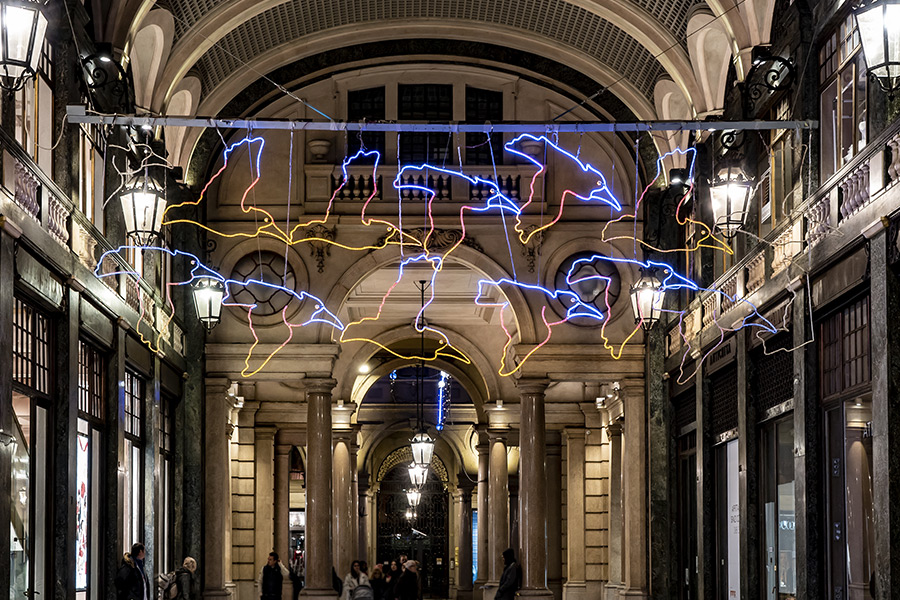Art is a way of designing the future: with utopian imagination it succeeds in proposing new ways of living, not just images. Art requires an ethical commitment: with respect to our lives, with respect to our communities, with respect to humanity as a whole, in the globalised world.
Piero Gilardi
The installation Migrazione (Climate Change) consists of 12 silhouettes of pelicans that, following an algorithm developed by Piero Gilardi with videomaker Heinrich Vogel, light up and go out one after the other, alternating the colours blue, purple, red and yellow that recall the sunset. As the title suggests, the flock flies in search of more favourable climates.
Best known for his Tappeti natura (Nature Carpets), which since 1965 bear witness to his precocious sensitivity to environmental themes, Piero Gilardi (Turin, 1942-2023) has embodied the figure of the militant artist from the very beginning. He was a member of Arte Povera, but as early as 1968 he chose to abandon his artistic practice to devote himself to the theoretical elaboration and activation of networks and exchanges between artists. He was in fact one of the protagonists of the Deposito d’Arte Presente and with his travels between Europe and the United States he aimed to bring artists together, imagining their potential self-management and contributing to the conception of two epoch-making exhibitions such as When Attitudes Become Form (Kunsthalle in Bern) and Op Losse Schroeven (Stedelijk Museum, Amsterdam), both in 1969.
In the 1980s he embraced New Media Art with the idea of exploring new possibilities of social coexistence and sharing, and in the following decade he created interactive multimedia installations as part of an intense international activity. In 2006 he founded the PAV – Parco d’Arte Vivente di Torino, which he describes as “an incubator of ecological civic consciousness” and for which in 2018 he created another light installation entitled L’albero del PAV (The PAV Tree).
Piero Gilardi participated in the Venice Biennale in 1993. His most recent and significant solo exhibitions include the retrospective at MAXXI in Rome (2017) and the exhibition dedicated to his Tappeti-Natura at Magazzino Italian Art, Cold Spring, New York (2022).
Silvia Maria Sara Cammarata
Previous locations
2015 at the Galleria Subalpina; from 2016 to 2023 at the Galleria San Federico
On the occasion of the Water Light Festival in Brixen, held from April to May 2024, Migrazione (Climate Change) was requested on loan to become part of the open-air art gallery of Brixen and its surroundings.
Specifiche tecniche
Frame, steel cables and neon-led tubes.



